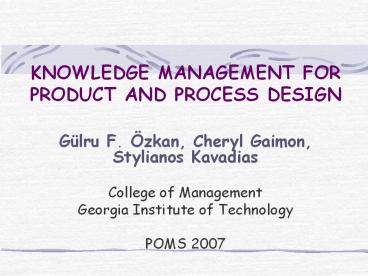KNOWLEDGE MANAGEMENT FOR PRODUCT AND PROCESS DESIGN - PowerPoint PPT Presentation
Title:
KNOWLEDGE MANAGEMENT FOR PRODUCT AND PROCESS DESIGN
Description:
product attributes and process capabilities ... Loch & Terwiesch (1996), Ha and Porteus (1995), Loch & Terwiesch (1998), Terwiesch et al. (2002) ... – PowerPoint PPT presentation
Number of Views:122
Avg rating:3.0/5.0
Title: KNOWLEDGE MANAGEMENT FOR PRODUCT AND PROCESS DESIGN
1
KNOWLEDGE MANAGEMENT FOR PRODUCT AND PROCESS
DESIGN
- Gülru F. Özkan, Cheryl Gaimon, Stylianos Kavadias
- College of Management
- Georgia Institute of Technology
- POMS 2007
2
MOTIVATION
- Knowledge ? source of competitive advantage
- We focus on knowledge management of the product
and process design teams - Teams embed knowledge ?
- product attributes and process capabilities
- Interface between knowledge management and new
product development
3
Knowledge Management Literature
- Learning-by-doing
- Lapre and Van Wassenhove (2000, 2001), Ittner et
al. (2001), Biskup and Simons (2004). - Knowledge Acquisition
- Mukherjee et al. (1998), Hatch and Mowery
(1998), Goldstein (2003), Carrillo Gaimon
(2000), (2004). - Knowledge transfer
- Argote Ingram (2000), Darr, Argote and Epple
(1995), Emery (2002), Szulanski (1996),
Zellmer-Bruhn (2003)
4
New Product Development Literature
- Concurrent Engineering
- Chakravarty (2001), Krishnan et al. (1997),
Smith Eppinger (1997), Eppinger (2001),
MacCormack Iansiti (2001) - Knowledge transfer
- Loch Terwiesch (1996), Ha and Porteus (1995),
Loch Terwiesch (1998), Terwiesch et al. (2002) - Simultaneous knowledge transfer
- Lado et al. (1997), Luo et al. (2006), Mihm
et al. (2003)
5
CONTRIBUTIONS
- Holistic view of knowledge management throughout
NPD project - Knowledge transfer in both directions
- No dependency structure between teams
- Capture complex and dynamic relationships between
knowledge levels of teams - Synergistic/conflicting impact of simultaneous
knowledge transfer - Capture tradeoff between launching inferior
product early and superior product late
6
RESEARCH QUESTIONS
- What drives the managers strategies for
knowledge transfer and knowledge acquisition of
the product and process design teams? - What is the effect of learning-by-doing?
- What is the effect of uncertainty resolution?
- When should the manager delay her pursuit of
knowledge transfer and why? - How does time to market pressure affect the
development of team knowledge?
7
KNOWLEDGE DYNAMICS
Knowledge acquisition
Knowledge acquisition
Knowledge transfer
Process Design M(t)
Product Design D(t)
Knowledge transfer
Learning-by-doing
Learning-by-doing
8
LEARNING-BY-DOING
Process Design
Product Design
M(t)
D(t)
aM(t)r1
aD(t)?1
9
KNOWLEDGE ACQUISITION
d2g(t)D(t)?4
m2g(t)M(t)r4
Process Design M(t)
Product Design D(t)
10
KNOWLEDGE TRANSFER
m1b(t)D(t)r2M(t)r3
Process Design M(t)
Product Design D(t)
d1?(t)M(t)?2D(t)?3
11
NET REVENUE V(X(T),Y(T),T)
- ? knowledge embedded by product process design
teams over development project. - Cumulative effective product team efforts
- X(T) d1(t)D(t)dt
- Cumulative effective process team efforts
- Y(T) d2(t)M(t)
- and T is the product release time (decision var.)
12
OBJECTIVE Maximize
- VX(T),Y(T),T
- - C1?(t)C2b(t)C3?(t),b(t)C4?(t)C5
g(t)dt - (1) (2) (3) (4)
(5) - Net revenue earned at the product release
- costs of pursuing
- (1)-(3) knowledge transfer including synergy vs.
conflict - and (4) (5) knowledge acquisition.
13
Rates of Knowledge Transfer and Acquisition
14
CASE 1 Knowledge Transfer and Acquisition for
Product Design Team
?(t)
?(t)
time
0
time
0
T
T
t?
t?
15
CASE 2 Knowledge Transfer and Acquisition for
Product Design Team
16
CASE 34 Knowledge Transfer and Acquisition for
Product Design Team
?(t) or ?(t)
time
0
T
t? or t?
17
Optimal Launch Time (T)
VX(T)?1(T)D(T)VY(T)?2(T)M(T) -VT
RHS
LHS
T
time
18
Optimal Launch Time (T)
19
Optimal Launch Time (T)
RHS
LHS
T
T2
time
20
INSIGHTS
- Rates of knowledge transfer acquisition for
product design team are larger if - Either teams rate of learning-by-doing is
larger - Returns of knowledge transfer in either direction
are larger - Returns of knowledge acquisition for the product
design team is larger - Marginal revenue earned from more product OR
process design team knowledge is larger - Uncertainty is resolved faster.
21
CONCLUSIONS
- Insights on KM of the product and process design
teams during an NPD project due to - Learning-by-doing.
- Drivers of revenue
- Rate of uncertainty resolution
- Disruption from knowledge acquisition or
transfer. - Initial level of product (process) design
knowledge. - Extent of time-based competition.
- Impact of conflict or synergy for simultaneous
knowledge transfer between teams.
22
FUTURE DIRECTIONS
- Analysis of different representations of
knowledge transfer effectiveness - Various net revenue functions at the product
release times reflecting different industries. - Numerical examples based on different industry
characteristics. - Consider forgetting, or knowledge depreciation.
- Imperfect knowledge transfer processes.































